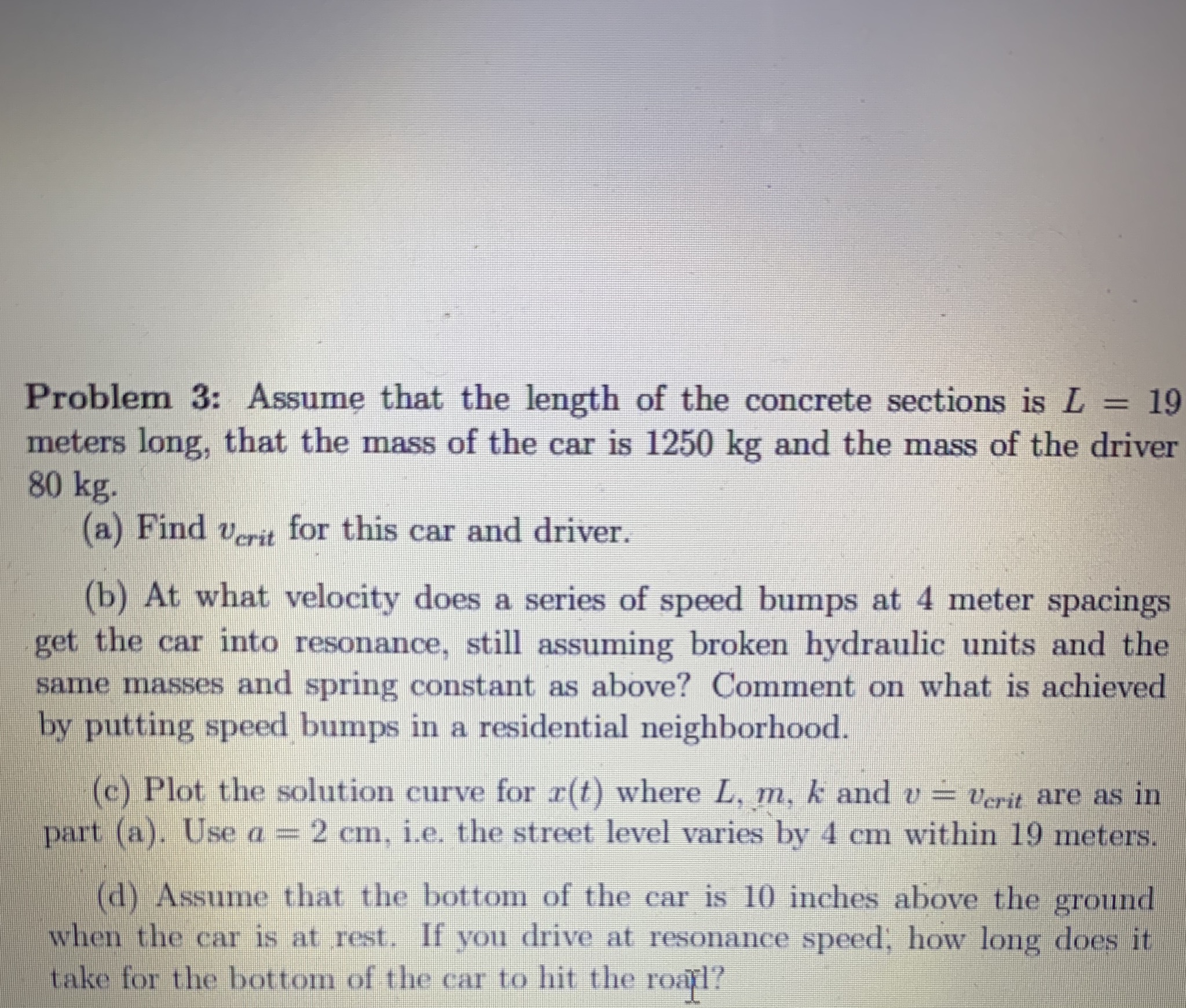Please provide solutions to the first and second question and third questions within the next 2 houres if possible
Problem 3: Assume that the length of the concrete sections is L = 19 meters long, that the mass of the car is 1250 kg and the mass of the driver 80 kg. (a) Find Verit for this car and driver. (b) At what velocity does a series of speed bumps at 4 meter spacings get the car into resonance, still assuming broken hydraulic units and the same masses and spring constant as above? Comment on what is achieved by putting speed bumps in a residential neighborhood. (c) Plot the solution curve for r(t) where L, m, k and v = Verit are as in part (a). Use a = 2 cm, i.e. the street level varies by 4 cm within 19 meters. (d) Assume that the bottom of the car is 10 inches above the ground when the car is at rest. If you drive at resonance speed, how long does it take for the bottom of the car to hit the roajl?2 Resonance for an undamped suspension sys- tem The result of Problem 1 is an inhomogeneous second order linear differential equation with constant coefficients. We will consider the special case where b - 0, i.e. there are no hydraulic units in the suspension, or the driver hasn't noticed that the hydraulic liquid has leaked out. In this case the DE found in Problem 1 describes driven motion without damping. When solving this DE we will work with the initial values r(0) = 0 and (0) = 0, i.e. the car initially rests in its equilibrium position. This initial value problem can be solved by the method of undetermined coefficients, separately for the resonant and non-resonant cases. Problem 2: Look up Sections 5.4 and 5.18 of the class notes for the defini- tions of the frequencies of free vibrations w and driving frequency y as well as Section 5.19 for the definition of pure resonance. (a) Express w/27 and the y/27 in terms of m. k, L and v. (b) Express the condition for pure resonance in terms of an equation for m. k. L and v. Solve this for v and call the resulting value v. This is the critical velocity at which the care will experience resonant vibrations. (c) From Sections 5.18 and 5.19 of the Notes, find the formulas for the solution r(t) of the DE found in Problem 1 with b = 0 and initial conditions r(0) = 0 and r(0) = 0. separately for the resonant and non-resonant cases Use the abbreviations w and ~ from part (a) as well as Fo = ka/ m to simplify the formulas. (We will insert specific numerical values for the constants later. )We will use a sine function to model the profile of the concrete sections of the road. Thus, using the z-axis for the direction of the road, the elevation of the road is given by h(z) = asin 2TZ (2) 0.107 0.05 0.05 -0.10 . Figure 2: The function h(z) for a = 0.02 m and L = 19 m Note that the period L of h(2) represents the length of the sections. while 2a, the maximal change of elevation, measures how much the sections are distorted. The axes in Figure 2. where the profile of the road is given for a = 2 cm and L = 19 m. are not to scale (the amplitude is much smaller relative to the length of the sections, meaning that the actual distortions of the road are quite small). Problem 1: The car travels at constant velocity a in the 2-direction. Find its position 2(t) after time / (assuming . (0) = 0) and insert this into (2) to find the function y = y(f) = h(2(f)) in (1). Also find y and insert both into (1). What is the resulting differential equation









